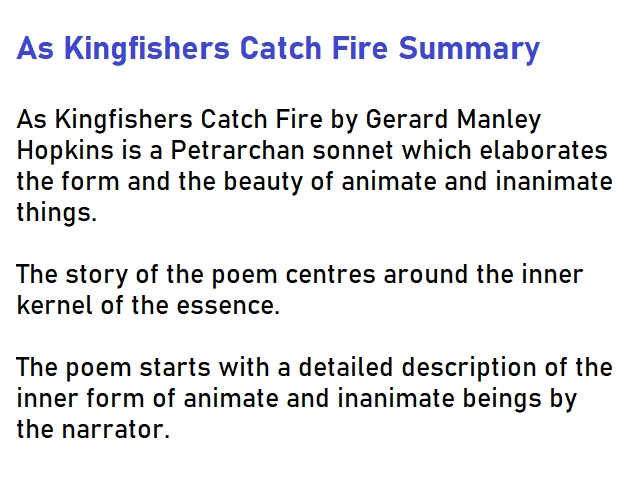As Kingfishers Catch Fire’s author Gerard Manley Hopkins’s writing has an essence of spirituality and romanticism in his literary works. He is one of the well-known poets of the Victorian age.
At the age of twenty-four, he is being transformed into Catholicism and later in the same year he becomes a priest. Hopkins’s works are mostly published posthumously. His writings are published in 1918, long after his death from typhoid fever.
His poetry is mostly about God and Nature and it often raises existential questions. To form his poetry Hopkins has used innovative imagery and rhyming to increase the complexity.
As Kingfishers Catch Fire, written by Hopkins is an accurate example of the query and the curiosity of the poet. He has incorporated unconventional rhythms and imagery to make his questions about God more powerful.

Table of Contents
As Kingfishers Catch Fire Summary
As Kingfishers Catch Fire by Gerard Manley Hopkins is a Petrarchan sonnet which elaborates the form and the beauty of animate and inanimate things. The story of the poem centres around the inner kernel of the essence.
The poem starts with a detailed description of the inner form of animate and inanimate beings by the narrator.
Like the dragonfly catches fire, the Kingfisher is catching fire. Next, the sound of a falling rock into a well and a hammer hitting the bell occurs. Through these two different sounds, the poet wanted to connect two animate and inanimate objects.
The poem has a deep sense of spirituality like any other poems of Hopkins. He shows the grace and inner structure of the animate and inanimate and compares this with human beings.
Hoskins goes on to say that if someone looks deep inside of a human being, they can visualize God inside them.
As Kingfishers Catch Fire Analysis
Petrarchan Sonnet
Hopkins has chosen the most traditional pattern to, write the poem. As Kingfishers Catch Fire by Gerard Manley Hopkins is a fourteen-line poem which qualifies it to be a Petrarchan sonnet.
It follows the rhyme scheme of ABBA ABBA CDC DCD. The Petrarchan sonnets are usually divided into two sections.
The first section has 8 lines and it is called octet and the following section has six lines which is the sestet. Octet has the rhyme pattern of ABBA ABBA but the sestet does not need to always follow the CDCDCD pattern.
Another technique of being a Petrarchan sonnet is the turn. This is basically a change or twist in the poem by the narrator. It can be the sequel of the first part also can be completely different and unexpected.
In this poem, the first section, the octet of the poem talks about humanity and examples of contemporary experiences in the world.
In the sestet, the narrator changes his tone and says about the originality of the experiences. He also brings spirituality into the poem which is a tradition of Hopkins’s poetry and speaks his mind.
Sprung Rhythm
Petrarchan sonnets usually follow the iambic pentameter. In this meter, each line consists of five sets of two beats. The pattern is the first syllable should be unstressed and the second one is stressed and this keeps continuing.
But Hopkins invents his own pattern of meter which is the Sprung Rhythm. In this pattern, there is a bunch of stressed syllables. Hopkins is fascinated by the sounds of the lines than the usual traditional sound of iambic pentameter pattern.
Hopkins has used this meter approximately in his every poem. By this pattern, it is easier to copy human speeches.
As Kingfishers Catch Fire Poem meaning
The Poem As Kingfishers Catch Fire means how a kingfisher catches fire is similar to the catch of flame of a dragonfly. It portrays the divine vision of Gerard Manley Hopkins that each creature and each object in the world has its own individuality and uniqueness.
Themes
Beauty of divinity
This theme reflects the beauty of humanities. God is present inside of every human according to Hopkins. So human nature represents the beauty of the divine spirit. Humanity makes a human more divine by nature.
Beauty is a central concept of Duns Scotus’s philosophy from which Hopkins, the poet-priest, has been greatly inspired.
Spirituality
Gerard Manley Hopkins is a priest poet. Since at the age of twenty-four he joins the Society of Jesus, spirituality leaves a great impact on his literary career. He is very much deeply associated with religion henceforth almost all of his poetry has an essence spirituality.
He has spent much time being a priest at the Catholic church. Meanwhile, he has only imagined, observed and write down according to his psyche. He has dedicated his poems to God.
He has questions about God and his ultimate omnipotence. He believes God is the creator of everything in this world. Most of his poems are semi-romantic and religious.
As usual in this poem, God comes in the middle of the poem, specifically in the last stanza of the poem. Hopkins’s goes on to religious investigations of the universe. He has used vivid imagery and metaphors to describe his religious beliefs.
Identity
In this poem, the theme of identification is identifying the self. Hopkins says how one should achieve the mercy of God. It will help the person for better self-understanding. In the first part of the poem is about humanity and human nature.
So Hopkins here emphasizes the fact of releasing the inner self first. If a person is able to understand himself, he will also understand God, because the portray of God reflects from within the self.
Existence
Hopkins has combined the themes of spirituality and identity and created a new theme of the existence of a self. The poet here sums up the equation of life by joining the two themes of his own spiritual view and identification.
Since the poem is about humanity, this theme shows the life, consciousness, nature and existence of a human being. The narrator is more concerned about the inner self of a human.